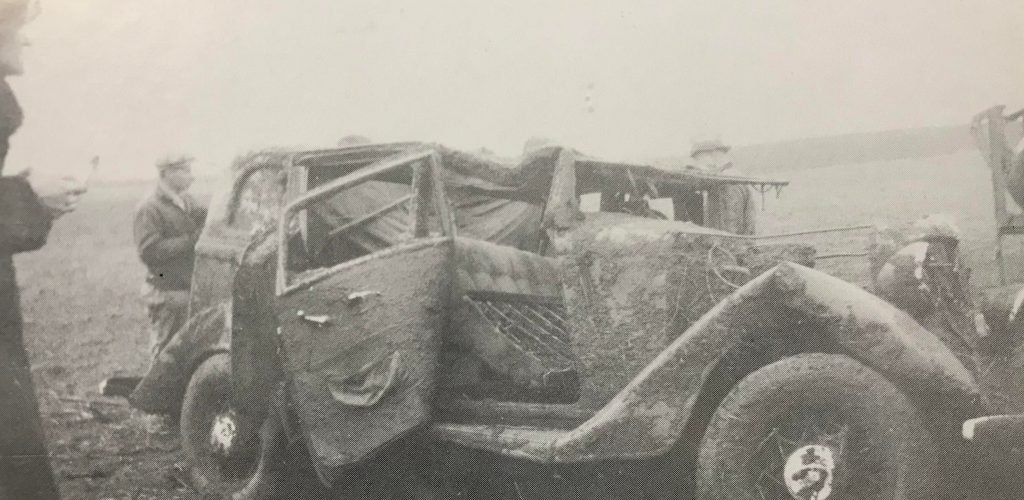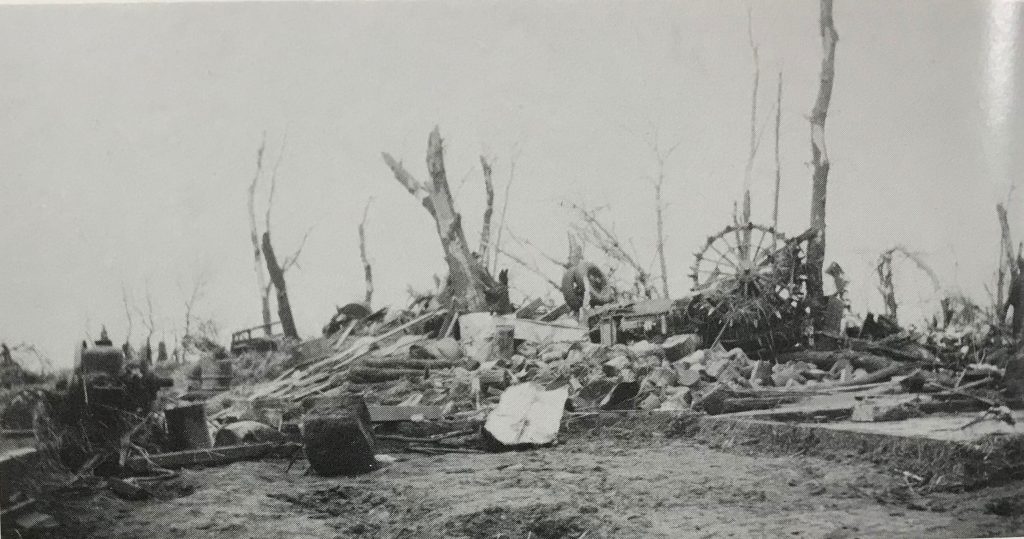The Tornado of 1936
West Okoboji, Dickinson County, Iowa

When Lake Okoboji finally thawed on April 13, 1936, after having been frozen to a depth of 34 inches through the worst winter in 116 years, no one could have imagined that a tornado would bring damage and two deaths just 17 days later, on April 30, 1936. It was all the more surprising, some claimed, as no tornado had hit the lakes of Dickinson County in the 79 years of its settler history. In fact, many believed that the lakes would prevent a tornado strike. On April 30, 1936, they revised those beliefs.
The heat rose on that sweltering, sultry afternoon until 4pm when the rain arrived in torrents, followed by hail—the worst of it the size of hens’ eggs. The tornado came out of the southwest, moving northeast from Everly. There was no radio alert. There were no alerts, writes R. Aubrey LaFoy. The tornado rose above the Little Sioux River and “swooped down again with renewed fury southwest of Terrence Park.” It first tore through two farms and then descended on the Terrence Park cottage section. Hattie Elston recounts the capricious progress of the storm: “Persons who were in that [Terrence Park] area said the winds howled and hissed down upon them through the south part of the park area and then turned toward the lake. It struck across the bay toward Pocahontas Point with a great geyser of water pulled into the air. The wind then apparently turned upon itself and swung back across the end of the lake to the highway and a farmhouse. The tornado lifted again and passed completely over Arnolds Park and the East Okoboji Lake area without the residents there even surmising the extent of the storm, and swooped down again to do further destruction in Fairmont County, Minnesota.” The estimated damage was $1million, half of that in Dickinson County.
LaFoy, who remembers a double funnel cloud, records that “the Rodome Club…was completely destroyed…swept off its foundation.” The owner, Mrs. H.A. Wilsey of Spencer, had just spent two weeks readying the club for the summer trade. On April 30, she was working at the club with three women, two men, and a 5-year-old daughter of one of the women when they suddenly found the air filled with dirt and debris. “Somebody shrieked, ‘Run for your lives to the cellar.’” Though they were not hurt, the tornado lifted the building over their heads and carried it away.
Two people were killed by the storm in Iowa. Mrs. Julius Heuer, who had given birth just a couple days earlier, was wrenched from her husband’s arms by the wind as he sought to carry her to a cellar. Herman Roskens was killed when, in a barnyard, the wind hurled a large horse on top of him. Quick thinking kept the death toll from being higher. A bus driver with a busload of children headed home from Arnolds Park School, drove the bus into a deep roadside ditch when he realized they were headed into the storm.
Hattie Elston provides a haunting description of the aftermath of the storm. In the dense fog, rain, and hail that followed the tornado, “volunteers from Milford and surrounding towns were sent to the country districts immediately to rescue farm animals and aid in whatever the emergency had provided for them to do. Many ex-soldiers said the night was reminiscent of many spent on French battlefields. Injured animals could be heard and not located. Hundreds of living things were killed in the most terrible way or injured.”
While families and friends, aided by the Red Cross, set to, cleaning up the mess, Elston describes “inevitable looting and souvenir-hunting” that began even that night and certainly the next day when crowds poured into the area to see the sights. Thousands created traffic jams in the lakes region. Men from the CCC (Civilian Conservation Corps) camp, called upon later that spring to participate in the building at Lakeside Labs, in these post-tornado days were ordered to stand guard. LaFoy remembers that his father directed traffic at Catholic Church corner so long, it was so hot, and so many cars’ radiators boiled over, that he was overcome by the fumes of radiator fluid and returned home hours later with a terrific headache.
Some fifty farmers who had already put spring crops in the ground had a headache of another kind: the effects of the tornado’s disruption of their fields.

Sources: SHSI: Hattie P. Elston, White Men Follow After: A Collection of Stories about the Okoboji-Spirit Lake Region, Spirit Lake, 1988; R. Aubrey LaFoy, Iowa Great Lakes Revisited, Hills MN, 1996; photo courtesy of Marilyn Baedke, Reflections in the Water: A Pictorial History of the Iowa Great Lakes, Spirit Lake, 1998.
